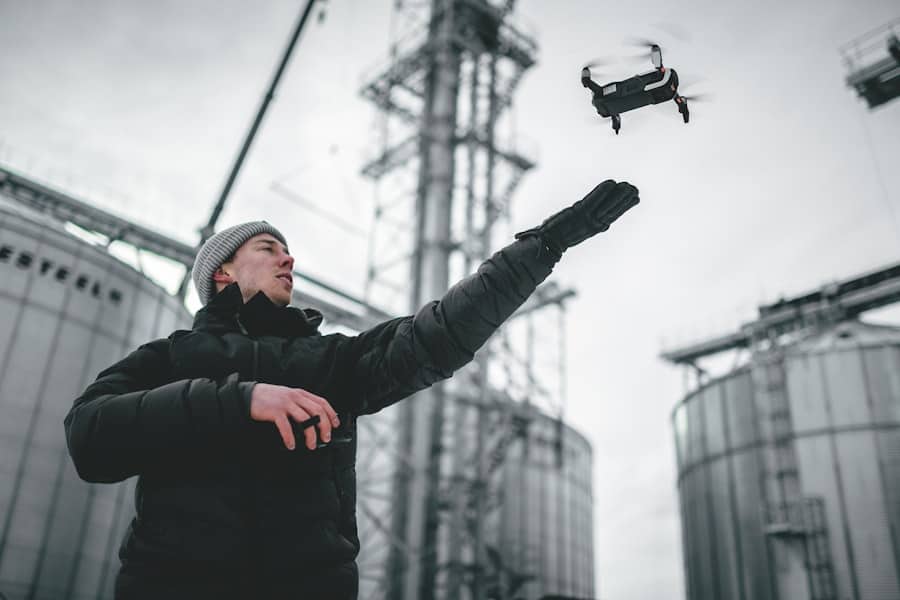The advent of consumer drones has revolutionized various sectors, from photography and videography to agriculture and delivery services. These unmanned aerial vehicles (UAVs) have become increasingly popular among hobbyists and professionals alike, thanks to their versatility and ease of use. However, one of the most significant limitations that users face is battery life.
Traditional consumer drones typically offer flight times ranging from 20 to 30 minutes, which can be a considerable constraint for users who require longer operational periods. The demand for drones with extended battery life has surged as enthusiasts and businesses seek to maximize their aerial capabilities without the constant need for recharging or battery swapping. Extended battery life in consumer drones is not merely a convenience; it represents a paradigm shift in how these devices can be utilized.
With advancements in battery technology, manufacturers are now exploring innovative solutions that promise to enhance flight durations significantly. This evolution is not just about keeping the drone airborne for longer; it opens up new possibilities for applications that were previously impractical due to time constraints. As the technology matures, the implications for both consumers and industries are profound, paving the way for a future where drones can operate more efficiently and effectively.
Key Takeaways
- Consumer drones with extended battery life offer longer flight times and increased operational capabilities for users.
- Current challenges and limitations of consumer drones include short battery life, limited flight range, and restricted operational time.
- Technological advancements in battery life for consumer drones, such as improved battery technology and energy-efficient designs, are addressing these limitations.
- Potential applications and uses for drones with extended battery life include aerial photography, surveillance, search and rescue operations, and delivery services.
- The impact on the drone industry and market includes increased demand for longer battery life drones, expanded use cases, and potential growth in the consumer and commercial drone sectors.
Current Challenges and Limitations of Consumer Drones
Despite the rapid growth of the consumer drone market, several challenges persist that hinder their full potential. One of the most pressing issues is battery life, which directly impacts flight time and operational range. Most consumer drones are equipped with lithium-polymer (LiPo) batteries, which, while lightweight and efficient, have inherent limitations in terms of energy density.
This means that even with optimal design and engineering, the maximum flight time remains constrained. Users often find themselves in situations where they must return to base prematurely to avoid battery depletion, which can be frustrating and limit the scope of their projects. Another significant challenge is the weight-to-power ratio.
As manufacturers strive to enhance battery capacity, they must also consider the added weight that larger batteries bring. This creates a delicate balance between extending flight time and maintaining the drone’s agility and performance. Additionally, environmental factors such as temperature and wind conditions can further exacerbate battery performance issues.
Cold weather can reduce battery efficiency, while strong winds can increase power consumption, leading to shorter flight times than anticipated. These challenges necessitate ongoing research and development to create solutions that address both battery longevity and overall drone performance.
Technological Advancements in Battery Life for Consumer Drones
Recent advancements in battery technology have begun to address some of the limitations faced by consumer drones. One promising area of research is the development of solid-state batteries, which offer higher energy density compared to traditional LiPo batteries. Solid-state batteries utilize a solid electrolyte instead of a liquid one, which not only enhances safety by reducing the risk of leaks or fires but also allows for greater energy storage in a smaller form factor.
This innovation could potentially double or even triple the flight time of consumer drones, enabling longer missions without the need for frequent recharges. Another exciting development is the integration of solar panels into drone designs. By harnessing solar energy during flight, drones can extend their operational time significantly.
While this technology is still in its infancy for consumer applications, prototypes have demonstrated the feasibility of solar-assisted flight. This could be particularly beneficial for agricultural drones that require extended periods of operation for tasks such as crop monitoring or pesticide application. Furthermore, advancements in energy management systems are allowing drones to optimize power usage more effectively, ensuring that every watt is utilized efficiently during flight.
Potential Applications and Uses for Drones with Extended Battery Life
The implications of drones with extended battery life are vast and varied across multiple sectors. In the realm of aerial photography and videography, longer flight times mean that filmmakers and photographers can capture more extensive footage without interruption. This capability is particularly advantageous for projects that require continuous shooting over large areas, such as landscape documentaries or real estate promotions.
The ability to stay airborne longer allows for more creative freedom and reduces the need for multiple drone setups or extensive planning around battery management. In agriculture, drones equipped with extended battery life can revolutionize farming practices. These drones can cover larger fields in a single flight, enabling farmers to conduct comprehensive crop monitoring, soil analysis, and even precision spraying without the constant need to land and recharge.
This efficiency not only saves time but also reduces operational costs associated with labor and equipment maintenance. Additionally, emergency services could benefit from longer-lasting drones for search and rescue operations or disaster response scenarios, where extended flight times can make a critical difference in locating individuals or assessing damage.
Impact on the Drone Industry and Market
The introduction of consumer drones with extended battery life is poised to have a significant impact on the drone industry as a whole. As manufacturers invest in research and development to create more efficient battery technologies, we can expect an influx of new models that cater specifically to consumers’ needs for longer flight times. This shift will likely lead to increased competition among manufacturers, driving innovation and potentially lowering prices as companies strive to capture market share.
Moreover, as extended battery life becomes a standard feature in consumer drones, we may witness an expansion in the user base beyond hobbyists and enthusiasts. Industries such as real estate, agriculture, construction, and logistics could see increased adoption of drone technology as operational capabilities improve. This broader acceptance will likely stimulate further investment in drone-related infrastructure, such as charging stations and maintenance services, creating a more robust ecosystem around drone technology.
Regulatory and Safety Considerations for Extended Battery Life Drones
Safety Concerns in the Skies
Longer flight times may lead to increased airspace congestion as more drones take to the skies simultaneously, necessitating a reevaluation of air traffic management systems to ensure safe operations and prevent collisions between UAVs and manned aircraft.
Establishing Clear Guidelines
Regulatory agencies will need to establish clear guidelines regarding altitude limits, no-fly zones, and operational protocols for extended-range flights. Additionally, safety considerations surrounding battery technology must be prioritized.
Ensuring Battery Reliability
Incidents involving battery malfunctions can pose significant risks not only to the drone itself but also to people and property on the ground. Regulatory bodies will likely implement stricter testing standards and certification processes for new battery technologies before they are approved for commercial use.
Environmental and Sustainability Implications of Longer Drone Battery Life
The environmental impact of consumer drones with extended battery life is a multifaceted issue that warrants careful consideration. On one hand, longer-lasting batteries can reduce the frequency of recharging cycles, leading to lower energy consumption over time. This efficiency could contribute positively to sustainability efforts by minimizing the carbon footprint associated with drone operations.
Furthermore, if solar-assisted technologies become mainstream, they could further enhance the environmental benefits by utilizing renewable energy sources during flights. Conversely, the production and disposal of advanced batteries raise concerns about resource extraction and waste management.
As demand for longer-lasting batteries increases, it will be crucial for manufacturers to adopt sustainable practices throughout the supply chain—from sourcing raw materials to recycling old batteries at the end of their lifecycle. The industry must prioritize environmentally friendly solutions to ensure that advancements in technology do not come at the expense of ecological health.
The Future of Consumer Drones with Extended Battery Life
The future of consumer drones with extended battery life appears promising as technological advancements continue to unfold. With innovations in battery technology paving the way for longer flight times, we can expect a transformation in how these devices are utilized across various sectors. The potential applications are vast, ranging from enhanced aerial photography capabilities to improved agricultural practices and emergency response operations.
As the industry evolves, it will be essential for stakeholders—including manufacturers, regulators, and consumers—to collaborate on addressing safety concerns and environmental implications associated with these advancements. By prioritizing sustainable practices and responsible regulations, we can harness the full potential of consumer drones while ensuring their integration into society is beneficial for all parties involved. The journey toward longer-lasting drones is just beginning, but its impact on technology and industry will undoubtedly shape the future landscape of aerial innovation.
If you are interested in the latest technology trends, you may also want to check out this article on com/apple-watch-vs-samsung-galaxy-watch/’>Apple Watch vs Samsung Galaxy Watch.
This comparison between two popular smartwatches can help you decide which one is the best fit for your lifestyle.
FAQs
What are consumer drones?
Consumer drones are unmanned aerial vehicles that are designed for recreational and personal use. They are equipped with cameras and other features that make them suitable for capturing photos and videos from the air.
What is extended battery life in consumer drones?
Extended battery life in consumer drones refers to the ability of the drone to fly for longer periods of time on a single battery charge. This allows users to capture more footage and explore larger areas without having to constantly land and recharge the drone.
Why is extended battery life important for consumer drones?
Extended battery life is important for consumer drones because it allows users to have longer flight times and more flexibility in capturing aerial footage. It also reduces the need for frequent battery changes or recharging, which can interrupt the drone’s operation.
What are the advancements in battery technology for consumer drones?
Advancements in battery technology for consumer drones include the development of lithium-polymer (LiPo) batteries, which are lightweight and have high energy density. There are also advancements in battery management systems and charging technologies that improve the overall performance and longevity of drone batteries.
How do extended battery life consumer drones impact the future of drone technology?
Extended battery life consumer drones are expected to impact the future of drone technology by enabling longer flight times, improved efficiency, and expanded capabilities for aerial photography, videography, and other applications. This will open up new possibilities for drone use in various industries and recreational activities.



